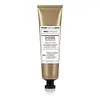What's inside
What's inside
 Key Ingredients
Key Ingredients

 Benefits
Benefits

 Concerns
Concerns

 Ingredients Side-by-side
Ingredients Side-by-side

Salicylic Acid 2%
MaskingWater
Skin ConditioningAlumina
AbrasiveBentonite
AbsorbentKaolin
AbrasiveMaltodextrin
AbsorbentPropanediol
SolventGlycerin
HumectantAloe Barbadensis Leaf Juice
Skin ConditioningCitric Acid
BufferingTitanium Dioxide
Cosmetic ColorantZinc Oxide
Cosmetic ColorantPhenoxyethanol
PreservativePolyacrylate Crosspolymer-6
Emulsion StabilisingPolysorbate 20
EmulsifyingProtease
ExfoliatingPotassium Sorbate
PreservativeSodium Benzoate
MaskingT-Butyl Alcohol
PerfumingTriethoxycaprylylsilane
Sodium Hyaluronate
HumectantEthylhexylglycerin
Skin ConditioningSalicylic Acid 2%, Water, Alumina, Bentonite, Kaolin, Maltodextrin, Propanediol, Glycerin, Aloe Barbadensis Leaf Juice, Citric Acid, Titanium Dioxide, Zinc Oxide, Phenoxyethanol, Polyacrylate Crosspolymer-6, Polysorbate 20, Protease, Potassium Sorbate, Sodium Benzoate, T-Butyl Alcohol, Triethoxycaprylylsilane, Sodium Hyaluronate, Ethylhexylglycerin
Water
Skin ConditioningGlycerin
HumectantGlycolic Acid
BufferingAmmonium Acryloyldimethyltaurate/Vp Copolymer
Propanediol
SolventPolyacrylate Crosspolymer-6
Emulsion StabilisingSodium Hydroxide
BufferingLactic Acid
Buffering3-O-Ethyl Ascorbic Acid
Skin ConditioningCarrageenan
Malpighia Glabra Fruit Juice
Skin ConditioningMalpighia Glabra Fruit Extract
Skin ConditioningSalicylic Acid
MaskingPanthenol
Skin ConditioningCaffeine
Skin ConditioningSodium Hyaluronate
HumectantTocopherol
AntioxidantRosmarinus Officinalis Leaf Extract
AntimicrobialHelianthus Annuus Extract
EmollientOryza Sativa Bran Extract
Skin ConditioningRaphanus Sativus Root Extract
AstringentLeuconostoc/Radish Root Ferment Filtrate
AntimicrobialLactobacillus
Skin ConditioningMaltodextrin
AbsorbentOleth-20
CleansingPentaerythrityl Tetra-Di-T-Butyl Hydroxyhydrocinnamate
AntioxidantSodium Benzotriazolyl Butylphenol Sulfonate
UV AbsorberSodium Phytate
Glyceryl Polyacrylate
Parfum
MaskingPhenoxyethanol
PreservativeCI 16035
Cosmetic ColorantWater, Glycerin, Glycolic Acid, Ammonium Acryloyldimethyltaurate/Vp Copolymer, Propanediol, Polyacrylate Crosspolymer-6, Sodium Hydroxide, Lactic Acid, 3-O-Ethyl Ascorbic Acid, Carrageenan, Malpighia Glabra Fruit Juice, Malpighia Glabra Fruit Extract, Salicylic Acid, Panthenol, Caffeine, Sodium Hyaluronate, Tocopherol, Rosmarinus Officinalis Leaf Extract, Helianthus Annuus Extract, Oryza Sativa Bran Extract, Raphanus Sativus Root Extract, Leuconostoc/Radish Root Ferment Filtrate, Lactobacillus, Maltodextrin, Oleth-20, Pentaerythrityl Tetra-Di-T-Butyl Hydroxyhydrocinnamate, Sodium Benzotriazolyl Butylphenol Sulfonate, Sodium Phytate, Glyceryl Polyacrylate, Parfum, Phenoxyethanol, CI 16035
Ingredients Explained
These ingredients are found in both products.
Ingredients higher up in an ingredient list are typically present in a larger amount.
Glycerin is already naturally found in your skin. It helps moisturize and protect your skin.
A study from 2016 found glycerin to be more effective as a humectant than AHAs and hyaluronic acid.
As a humectant, it helps the skin stay hydrated by pulling moisture to your skin. The low molecular weight of glycerin allows it to pull moisture into the deeper layers of your skin.
Hydrated skin improves your skin barrier; Your skin barrier helps protect against irritants and bacteria.
Glycerin has also been found to have antimicrobial and antiviral properties. Due to these properties, glycerin is often used in wound and burn treatments.
In cosmetics, glycerin is usually derived from plants such as soybean or palm. However, it can also be sourced from animals, such as tallow or animal fat.
This ingredient is organic, colorless, odorless, and non-toxic.
Glycerin is the name for this ingredient in American English. British English uses Glycerol/Glycerine.
Learn more about GlycerinMaltodextrin is a polysaccharide. It is derived from starch such as rice, corn, wheat, or potato starch.
In food, Maltodextrin is used to improve the texture and thicken a product. Due to its structure, it can help create a gel texture. As an emulsion stabilizer, it helps keep the ingredients in a product together.
As a polysaccharide, Maltodextrin has moisturizing properties. Polysaccharides are a type of carbohydrate. The top layer of skin uses polysaccharides to retain water, keeping the skin hydrated.
Maltodextrin is water soluble and has a sweet taste.
Learn more about MaltodextrinPhenoxyethanol is a preservative that has germicide, antimicrobial, and aromatic properties. Studies show that phenoxyethanol can prevent microbial growth. By itself, it has a scent that is similar to that of a rose.
It's often used in formulations along with Caprylyl Glycol to preserve the shelf life of products.
Polyacrylate Crosspolymer-6 is a texture enhancer and pH adjuster.
It is be used to thicken water-based products and create a gel-texture with a velvet feel.
One manufacturer claims this ingredient to have a pH range of 2-8 and to be biodegradable.
Learn more about Polyacrylate Crosspolymer-6Propanediol is an all-star ingredient. It softens, hydrates, and smooths the skin.
It’s often used to:
Propanediol is not likely to cause sensitivity and considered safe to use. It is derived from corn or petroleum with a clear color and no scent.
Learn more about PropanediolSalicylic Acid (also known as beta hydroxy acid or BHA) is a well-known ingredient for treating skin that struggles with acne and clogged pores. It exfoliates both the skin's surface and deep within the pores to help clear out buildup, control oil, and reduce inflammation.
Unlike AHAs (alpha hydroxy acids), salicylic acid is oil-soluble. This allows it to penetrate into pores which makes it especially effective for treating blackheads and preventing future breakouts.
Salicylic acid is also known for its soothing properties. It has a similar structure to aspirin and can calm inflamed or irritated skin, making it a good option for acne-prone skin that is also sensitive.
Concentrations of 0.5-2% are recognized by the U.S. FDA as an over-the-counter topical acne product.
It can cause irritation and/or dryness if one's skin already has a compromised moisture barrier, so it's best to focus on repairing that before introducing this ingredient into your routine.
While salicylic acid does not increase sun sensitivity, it’s still important to wear sunscreen daily to protect your skin.
If you are looking for the ingredient called BHA or Butylated Hydroxyanisole, click here.
Learn more about Salicylic AcidSodium Hyaluronate is hyaluronic acid's salt form. It is commonly derived from the sodium salt of hyaluronic acid.
Like hyaluronic acid, it is great at holding water and acts as a humectant. This makes it a great skin hydrating ingredient.
Sodium Hyaluronate is naturally occurring in our bodies and is mostly found in eye fluid and joints.
These are some other common types of Hyaluronic Acid:
Learn more about Sodium HyaluronateWater. It's the most common cosmetic ingredient of all. You'll usually see it at the top of ingredient lists, meaning that it makes up the largest part of the product.
So why is it so popular? Water most often acts as a solvent - this means that it helps dissolve other ingredients into the formulation.
You'll also recognize water as that liquid we all need to stay alive. If you see this, drink a glass of water. Stay hydrated!
Learn more about Water